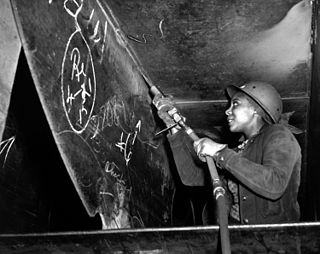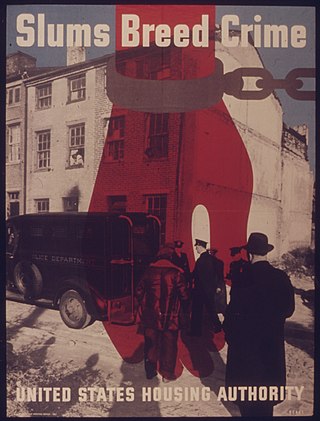Related Research Articles

The Public Works Administration (PWA), part of the New Deal of 1933, was a large-scale public works construction agency in the United States headed by Secretary of the Interior Harold L. Ickes. It was created by the National Industrial Recovery Act in June 1933 in response to the Great Depression. It built large-scale public works such as dams, bridges, hospitals, and schools. Its goals were to spend $3.3 billion in the first year, and $6 billion in all, to supply employment, stabilize buying power, and help revive the economy. Most of the spending came in two waves, one in 1933–1935 and another in 1938. Originally called the Federal Emergency Administration of Public Works, it was renamed the Public Works Administration in 1935 and shut down in 1944.

The Home Owners' Loan Corporation (HOLC) was a government-sponsored corporation created as part of the New Deal. The corporation was established in 1933 by the Home Owners' Loan Corporation Act under the leadership of President Franklin D. Roosevelt. Its purpose was to refinance home mortgages currently in default to prevent foreclosure, as well as to expand home buying opportunities.
The Reconstruction Finance Corporation (RFC) was a government corporation administered by the United States Federal Government between 1932 and 1957 that provided financial support to state and local governments and made loans to banks, railroads, mortgage associations, and other businesses. Its purpose was to boost the country's confidence and help banks resume daily functions after the start of the Great Depression. The RFC became more prominent under the New Deal and continued to operate through World War II. It was disbanded in 1957, when the US Federal Government concluded that it no longer needed to stimulate lending.

The Works Progress Administration was an American New Deal agency that employed millions of jobseekers to carry out public works projects, including the construction of public buildings and roads. It was set up on May 6, 1935, by presidential order, as a key part of the Second New Deal.

Winfield Township is a township in Union County, in the U.S. state of New Jersey. As of the 2020 United States census, the township's population was 1,423, its lowest decennial census and a decrease of 48 (−3.3%) from the 2010 census count of 1,471, which in turn reflected a decline of 43 (−2.8%) from the 1,514 counted in the 2000 census. The township is the sixth-smallest municipality in the state. Winfield and Linden share the same ZIP Code.

Rosie the Riveter World War II Home Front National Historical Park is a United States national historical park located in Richmond, California, near San Francisco. The park preserves and interprets the legacy of the United States home front during World War II, including the Kaiser Richmond Shipyards, the Victory ship SS Red Oak Victory, a tank factory, housing developments and other facilities built to support America's entry into World War II. In particular, the role of women and African-Americans in war industries is explored and honored.

The Federal Home Loan Bank Board (FHLBB) was a board created in 1932 that governed the Federal Home Loan Banks also created by the act, the Federal Savings and Loan Insurance Corporation (FSLIC) and nationally-chartered thrifts. It was abolished and superseded by the Federal Housing Finance Board and the Office of Thrift Supervision in 1989 due to the savings and loan crisis of the 1980s, as Federal Home Loan Banks gave favorable lending to the thrifts it regulated leading to regulatory capture.

Canada Mortgage and Housing Corporation is Canada's federal crown corporation responsible for administering the National Housing Act, with the mandate to improve housing by living conditions in the country.
The Office of Administrator of Export Control was established in the United States by Presidential Proclamation 2413, July 2, 1940, to administer export licensing provisions of the act of July 2, 1940. Brigadier General Russell Lamont Maxwell, United States Army, headed up this military entity. It was abolished by Presidential Executive Order 8900, September 15, 1941, and its functions were transferred to the Economic Defense Board, which had been established by Presidential Executive Order 8839, July 30, 1941, to develop policies and programs to strengthen U.S. international economic relations. The name was changed to Board of Economic Warfare by Presidential Executive Order 8982, December 17, 1941. In turn, it was abolished by Executive Order 9361, July 15, 1943, and the functions were transferred to the newly created Office of Economic Warfare, OEM, which also assumed control of U.S. Commercial Company, Rubber Development Corporation, Petroleum Reserves Corporation, and Export-Import Bank of Washington from the Reconstruction Finance Corporation. Consolidated into the Foreign Economic Administration, 1943.

Colonial Hills is a subdivision of 873 single-family homes located in the city of Worthington, Ohio, a northern suburb of the state capital, Columbus. Built by the Defense Homes Corporation to meet the needs of World War II production and the post-war boom, it continues to be a viable community today.

The United States Housing Authority, or USHA, was a federal agency created during 1937 within the United States Department of the Interior by the Housing Act of 1937 as part of the New Deal.


Atchison Village is a community in Richmond, California which was originally built as housing for defense workers from the Kaiser Shipyards. It lies at an elevation of 13 feet. Constructed by the Richmond Housing Authority in 1941 as Richmond's first public defense housing project, it is one of the only projects funded by the Community Facilities Act of 1940 that still exists in Richmond and one of the few in the nation not destroyed after the war. It is one of 20 public housing projects built in Richmond before and during World War II. The Village was sold by the government to its residents for $1,512,00.00 February 28, 1957, remaining mutual housing to this day under the ownership of the Atchison Village Mutual Homes Corporation. Many think it would be covered under Proposition 13 as a single unsold parcel, thus limiting tax increases to 2%, but the Tax Assessor does not treat it that way.
The War Assets Administration (WAA) was created to dispose of United States government-owned surplus material and property from World War II. The WAA was established in the Office for Emergency Management, effective March 25, 1946, by Executive Order 9689, January 31, 1946. It was headed by Robert McGowan Littlejohn.
Colonel Lawrence Westbrook was a Texan politician and official in the administration of President Franklin D. Roosevelt. A 1908 graduate of the University of Texas and later the University of Texas Law School. Colonel Westbrook also served as a member of the Texas Legislature representing Waco, Texas. During World War I he attained the rank of lieutenant colonel in the Army Signal Corps. He was among the pallbearers of Felix Huston Robertson, a war-criminal known for the Saltville Massacre of black soldiers and as the last surviving general of the Confederate States of America. He married Mrs. Martha Wootton Collings in Hot Springs, Arkansas in March 1937. During World War II Colonel Westbrook returned to active duty and was wartime president of the United States Purchasing Board in the South Pacific theater where he was awarded the Order of the British Empire from New Zealand. While serving in the South Pacific he was responsible for a survey of all defense resources for this region. Colonel Westbrook died January 24, 1964 in San Angelo, Texas.
The Mutual Ownership Defense Housing Division of the Federal Works Agency, an agency of the United States government, operating from about 1940 to 1942 under the leadership of Colonel Lawrence Westbrook, was an attempt by the United States Government, late in the New Deal, to respond to the housing needs facing defense workers and develop housing projects for middle-income families utilizing the cooperative/mutual housing ownership concept. Under pressure by entrenched real estate interests and intense and competing resource needs caused by World War II, the Division lasted for only two years. As stated in the Second Annual Report of the Federal Works Agency:
"As a group, defense workers were also poor candidates for individual home ownership because the duration of their employment was uncertain, and because few of them had savings adequate to finance the downpayment on new homes. Recognizing these characteristics, attention was given early to some special form of housing to meet squarely the economic problem of the defense worker and one which, at the same time, might lead to an ultimate solution of the housing problems of millions of other American families of similar economic status."
The Federal Works Agency (FWA) was an independent agency of the federal government of the United States which administered a number of public construction, building maintenance, and public works relief functions and laws from 1939 to 1949. Along with the Federal Security Agency and Federal Loan Agency, it was one of three catch-all agencies of the federal government pursuant to reorganization plans authorized by the Reorganization Act of 1939, the first major, planned reorganization of the executive branch of the government of the United States since 1787.
Christeele Acres Historic District is a residential subdivision in Orem, Utah, built in 1943 as housing for workers at the Geneva Steel plant during World War II. The historic district includes 62 single-family houses and three duplexes. The houses were built to Federal Housing Administration (FHA) "minimum house" standards, which were considered to be the minimum size of a house necessary for a family with three persons or a family with two small children. The houses had two bedrooms and approximately 700 square feet (65 m2) of living space.
The Fair Employment Practice Committee (FEPC) was created in 1941 in the United States to implement Executive Order 8802 by President Franklin D. Roosevelt "banning discriminatory employment practices by Federal agencies and all unions and companies engaged in war-related work." That was shortly before the United States entered World War II. The executive order also required federal vocational and training programs to be administered without discrimination. Established in the Office of Production Management, the FEPC was intended to help African Americans and other minorities obtain jobs in home front industries during World War II. In practice, especially in its later years, the committee also tried to open up more skilled jobs in industry to minorities, who had often been restricted to lowest-level work. The FEPC appeared to have contributed to substantial economic improvements among black men during the 1940s by helping them gain entry to more skilled and higher-paying positions in defense-related industries.

The Defense Plant Corporation,(DPC), was subsidiary of the Reconstruction Finance Corporation, a government corporation run by the United States Federal Government between 1940 and 1945. To win World War II the United States and its Allied Nations needed massive war production. Many private companies did not have the capital funds to meet the wartime demand for buildings and equipment. Defense Plant Corporation provided financial support to state and local governments. Defense Plant Corporation also made loans to banks, railroads, mortgage associations, and other businesses supporting the war efforts.
References
- 1 2 Records of the Reconstruction Finance Corporation, Guide to Federal Records, National Archives and Records Administration, retrieved 14 Sep. 2009